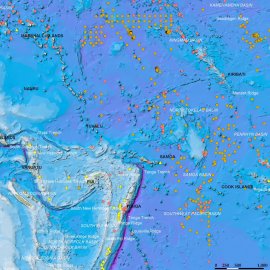Deep Sea Mining Update, Part Two
-
English
-
ListenPause
[intro music] Welcome to World Ocean Radio… I’m Peter Neill, Director of the World Ocean Observatory. In last week’s World Ocean Radio, I discussed the financial difficulties of the Nautilus deep-sea mining venture off Papua New Guinea, a project that had generated enough local opposition and shareholder doubt that its major financing had been lost and devolved to short-term, high-interest loans from companies controlled by Russian oligarchs. The project, like other similar extraction ventures in the ocean, was proving financially impractical, controversial, and threatened by complication, possible fraud, and collapse. But, as I questioned at the end of that edition, what’s next? The next challenge may well be recovery of what are called “battery metals”: cobalt, nickel, and lithium, the stuff of alternative energy solutions for electrical storage, electric vehicles, and longer, stronger battery life for the myriad devices and processes that will need a constant reliable source to power burgeoning new functionality independent of fossil fuels. Today, demand for available supply and prices for these metals are high, and futures unsure, thus extraction profiteers are drawn to a new opportunity. In an article published June 5, 2018, by Krypton Ocean, one suggestion for “what’s next” was presented: yes, seabed mining, in particular mining technology that would use “the oceans to recreate seabed minerals to compensate our extraction activity” on land. The article reviews historical mineral assessments and research, zones high in probable deposits, improved extraction feasibility, and market requirements in support of a new “metal-dependent electric-driven economy,” and argues for such enterprise in a context of “regeneration,” a surprising justification that suggests that these metals are “renewable” as they have accreted over time (thousands of years, it must be said) and can do so again. The paradox of short-term consumption versus long-term “regeneration vision” is astonishing. The rationale is based on the fact of a vast area of the ocean floor, with hundreds of millions of tons of rare earth metals scattered in the form of sediments, ridges, crusts, nodules, metal-containing mud, and volcanogenic sulphide deposits in trenches and mountains – all available to extract in support a lifestyle ever-dependent on storage technology and indifferent to environmental consequence. Scale enables localization of damage, the very same argument that has been used to justify extractive damage on land worldwide. Mitigation is offered in the form of pace and new methods for recovery: schedule, restricted areas, and deep-water vehicles that collect nodules as if harvesting crops. “The strategy should imply a partial extraction of nodules from some spots of a deposit (selected in a chequered manner, for instance) giving benthic creatures an opportunity to repopulate as well as maintaining a natural balance between all components of the environmental media of the developed area.” Sludge, affect in the water column, the value of destroyed habitat, mitigation cost, ecosystem loss—all of these are acknowledged but dissolved in strategies of best intention. The argument focuses on the ocean as “a global biochemical laboratory” and then imposes a regime that is geological and mineralogical, not biological or chemical at all. There is a discussion of governance. The International Seabed Authority exists as possible apparatus for adjudication, but permitting is mostly local, enforcement is as problematic for mining offshore as it is for oil and gas drilling, regulation is subject to varied jurisdictions and limited monitoring, plans for mitigation and redress of eco-damage is left for later, insurance for cleanup and consequence is left unaddressed. Krypton Ocean concludes, “Nothing prevents us from making seabed mining the most eco-friendly extractive activity in history since a well-developed innovative technology of the autonomous seabed harvesters is available. Now all that’s left is to put the technology into practice. Who’s first?” Isn’t it ironic? The answer to what’s next is, “who’s first.” This is a vicious, revolving circle of old reasoning linked to a new technology adapted, now that the land has been exhausted, to the destruction of the ocean, the last bio-reserve on earth that must thrive to serve us beyond electric-driven dependency to insure the full spectrum of energy for living. We will discuss these issues, and more, in future editions of World Ocean Radio. WORLD OCEAN RADIO IS DISTRIBUTED BY THE PUBLIC RADIO EXCHANGE AND THE PACIFICA NETWORK FOR USE BY COLLEGE AND COMMUNITY RADIO STATIONS WORLDWIDE. FIND US WHEREVER YOU LISTEN TO YOUR FAVORITE PODCASTS, AND AT WORLD OCEAN OBSERVATORY DOT ORG.
In this episode, part two of a 2-part series on deep sea mining, we pick up where we left off by taking on the question of "what's next?" in the wake of the failures of the Nautilus deep sea mining venture in Papua New Guinea. We discuss the challenges for future exploration and extraction of rare earth minerals used in alternative energy production and question how we can justify taking these resources in our quest to develop new and innovative technologies for the 21st century and beyond.
Deep Sea Mining Update, part one is available here.
The weekly blog post of this episode is available at Medium.com/@TheW2O.
About World Ocean Radio
Peter Neill, Director of the World Ocean Observatory and host of World Ocean Radio, provides coverage of a broad spectrum of ocean issues from science and education to advocacy and exemplary projects. World Ocean Radio is a weekly series of five-minute audio essays available for syndicated use at no cost by college and community radio stations worldwide.
Image Credit
International Seabed Authority Maps
Resources from this Episode
< Krypton Ocean Group
< International Seabed Authority
- Login to post comments



